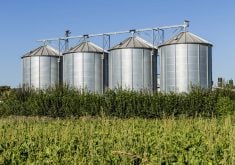Relatively bearish production estimates for this year’s soybean and corn crops in the United States did little to weigh on the grain markets, with prices in both crops up considerably in the immediate aftermath of the U.S. Department of Agriculture’s Aug. 12 production report.
However, ICE Futures canola lacked much spillover buying interest, as strength in the Canadian dollar and the looming harvest weighed on values.
The USDA is forecasting record-large soybean and corn yields, of 53.3 bushels per acre and 181.3 bu./ac. respectively. The agency expects corn production to hit a record of 15.27 billion bushels, while the soybean crop would be the second biggest ever if the 4.42-billion-bushel forecast is realized.
Read Also

Drones jumpstart cover crop planting
Drones are a tool that can help farmers with cover crop planting in still-growing corn and soybeans.
While the large soybean and corn crops beat expectations, the U.S. futures had a ‘sell the rumour, buy the fact’ reaction. Soybeans and corn both posted double-digit gains in the days following the USDA report, with chart-based speculative buying a feature. A windstorm that hit a large part of the Midwest during the week damaged crops, and likely cut into the actual production.
However, canola failed to see much strength of its own despite the gains in the U.S. futures. Part of the relative weakness in canola was likely tied to the strength in the Canadian dollar, which hit its best levels in six months during the week. That higher currency cuts into crush margins and makes exports less attractive to international buyers.
Fund selling was another bearish feature in canola. After putting on the largest net long position in two years, the futures were thought to be looking overbought from a technical standpoint. As a result, speculators were back on the sell side booking profits.
November canola had hit levels in the $490- to $494-per-tonne area at the start of August, after trending higher all through July. However, that proved the upper edge of the market for the time being, with values back in the $484- to $486-per-tonne level by the middle of the month.
With seasonal harvest pressure just around the corner, the highs for canola may be in for the time being. However, a weather scare or other outside influence could change that outlook.
While highly varied across the Prairies, general expectations are pointing to a large canola crop this year. Many early estimates are topping 20 million tonnes, which would compare with last year’s 18.6-million-tonne crop.
The canola exports and domestic crush both topped 10 million tonnes in 2019-20, according to preliminary data, which means the country needs at least a 20-million-tonne crop to meet demand if that pace continues.
Statistics Canada releases its first official survey-based production estimates on Aug. 28, and market participants will be following it closely for direction.
















